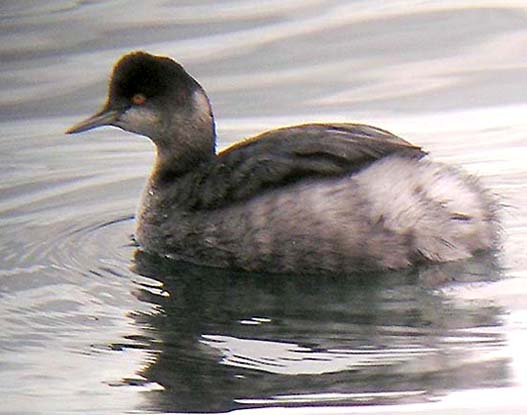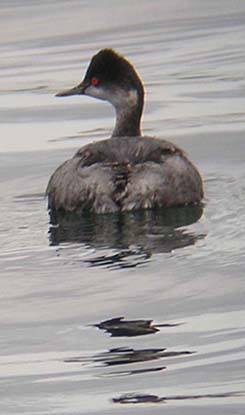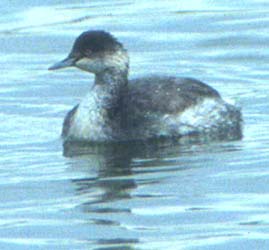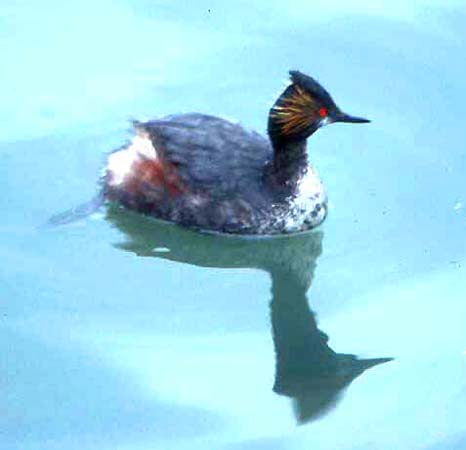 |
 |
| Eared Grebe is a common and widespread migrant and winter visitor to both freshwater and inshore saltwater habitats in Monterey County (MTY). Some beginning arriving in September, big numbers are in by late October and these birds remain through March. Numbers begin declining in April and are much reduced by May. Only a very few remain through the summer. These latter birds have been non-breeders, but it is possible that Eared Grebe may nest in MTY under prime conditions in the future. |
 |
 |
| Eared Grebes are small gray-and-white grebes with short, thin, very
slightly upturned bills. They tend to have a 'peaked' appearance to the
crown above the eye, and often carry their rear ends fluffed up. There
is much smudgy dark color on the neck and face, separating the white on
the face to two white 'hot spots' rather than a uniformly white cheek.
First-year birds have yellow eyes (above left) but adults and all grebes
later in the winter in red eyes (above right).
Both photos digiscoped 9 Jan 2004 Monterey
harbor © D. Roberson.
|
 When
Eared Grebes first arrive in autumn, some first-year birds, like the one
shown (right), appear to have much whiter cheeks, have more white
on the neck, show a flatter crown, and don't also hold the rear-end fluffed
up. These birds can be misidentified as "Horned Grebes". Please see a more
detailed
page on this identification problem. Eared Grebes are always less bulky,
thinner, and more delicate than Horned Grebes. When
Eared Grebes first arrive in autumn, some first-year birds, like the one
shown (right), appear to have much whiter cheeks, have more white
on the neck, show a flatter crown, and don't also hold the rear-end fluffed
up. These birds can be misidentified as "Horned Grebes". Please see a more
detailed
page on this identification problem. Eared Grebes are always less bulky,
thinner, and more delicate than Horned Grebes.
Photo 23 Oct 2004 Roberts Lake © D. Roberson |
 |
By spring, most Eared Grebes are in various states of molt into full
breeding plumage (left). They develop bright red eyes, blackish necks,
rusty flanks, and golden facial plumes. In all plumages, however, they
remain a lightweight grebe with a short, thin bill that usually looks slightly
upturned. Note the dark bill tip in all plumages.
Photo Apr 1999 Monterey harbor © D. Roberson |
Where to find a Eared Grebe in MTY: This small grebe is common
and widespread in migration and winter. Favored locales are:
|
|
MONTEREY GREBES Portal |
GREBE IN SEQUENCE Western Grebe |
Use the following links to other portions of the MTY checklist:
Part 1: Waterfowl through GrebesReaders may use this material for their own private enjoyment, study, or research but none of the photos or text herein may be used commercially nor may they be reposted on other web sites without written permission. All material is copyrighted. The posting of photos and text on this private web site is not a submission to review organizations.
Part 2: Albatrosses through Frigatebirds
Part 3: Herons through Cranes
Part 4: Plovers through Sandpipers
Part 5: Jaegers through Alcids
Part 6: Doves through Woodpeckers
Part 7: Flycatchers through Larks
Part 8: Swallows through Pipits
Part 9: Waxwings through Warblers
Part 10: Tanagers through Sparrows
Part 11: Grosbeaks through Finches
or just the plain Checklist (no annotations)